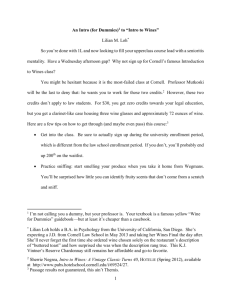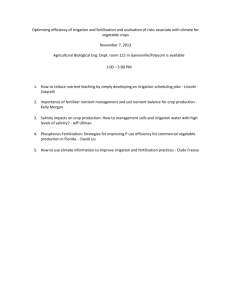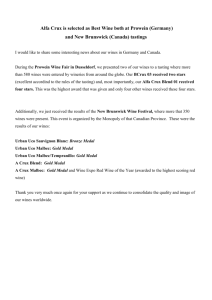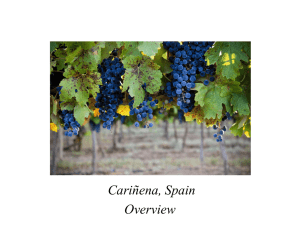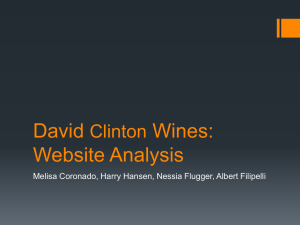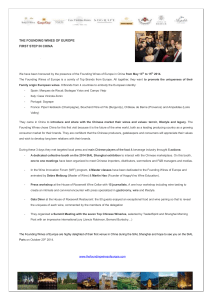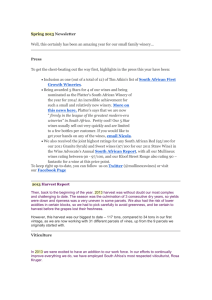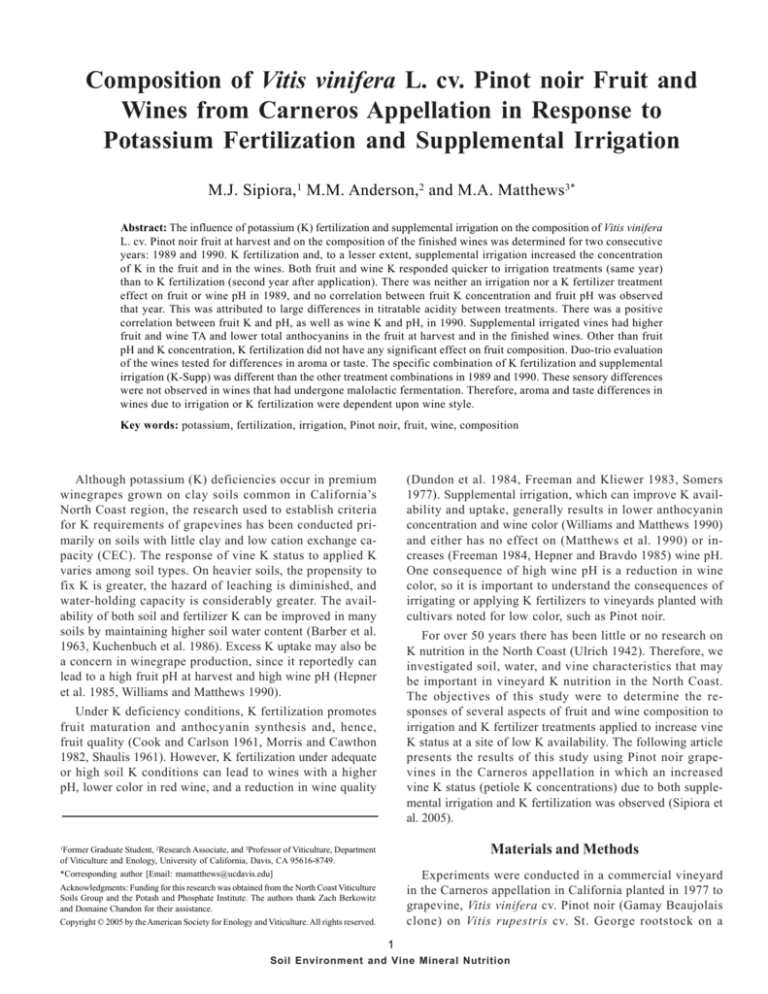
Response of Pinot noir to Potassium and Irrigation – 1
Composition of Vitis vinifera L. cv. Pinot noir Fruit and
Wines from Carneros Appellation in Response to
Potassium Fertilization and Supplemental Irrigation
M.J. Sipiora,1 M.M. Anderson,2 and M.A. Matthews3*
Abstract: The influence of potassium (K) fertilization and supplemental irrigation on the composition of Vitis vinifera
L. cv. Pinot noir fruit at harvest and on the composition of the finished wines was determined for two consecutive
years: 1989 and 1990. K fertilization and, to a lesser extent, supplemental irrigation increased the concentration
of K in the fruit and in the wines. Both fruit and wine K responded quicker to irrigation treatments (same year)
than to K fertilization (second year after application). There was neither an irrigation nor a K fertilizer treatment
effect on fruit or wine pH in 1989, and no correlation between fruit K concentration and fruit pH was observed
that year. This was attributed to large differences in titratable acidity between treatments. There was a positive
correlation between fruit K and pH, as well as wine K and pH, in 1990. Supplemental irrigated vines had higher
fruit and wine TA and lower total anthocyanins in the fruit at harvest and in the finished wines. Other than fruit
pH and K concentration, K fertilization did not have any significant effect on fruit composition. Duo-trio evaluation
of the wines tested for differences in aroma or taste. The specific combination of K fertilization and supplemental
irrigation (K-Supp) was different than the other treatment combinations in 1989 and 1990. These sensory differences
were not observed in wines that had undergone malolactic fermentation. Therefore, aroma and taste differences in
wines due to irrigation or K fertilization were dependent upon wine style.
Key words: potassium, fertilization, irrigation, Pinot noir, fruit, wine, composition
(Dundon et al. 1984, Freeman and Kliewer 1983, Somers
1977). Supplemental irrigation, which can improve K availability and uptake, generally results in lower anthocyanin
concentration and wine color (Williams and Matthews 1990)
and either has no effect on (Matthews et al. 1990) or increases (Freeman 1984, Hepner and Bravdo 1985) wine pH.
One consequence of high wine pH is a reduction in wine
color, so it is important to understand the consequences of
irrigating or applying K fertilizers to vineyards planted with
cultivars noted for low color, such as Pinot noir.
Although potassium (K) deficiencies occur in premium
winegrapes grown on clay soils common in California’s
North Coast region, the research used to establish criteria
for K requirements of grapevines has been conducted primarily on soils with little clay and low cation exchange capacity (CEC). The response of vine K status to applied K
varies among soil types. On heavier soils, the propensity to
fix K is greater, the hazard of leaching is diminished, and
water-holding capacity is considerably greater. The availability of both soil and fertilizer K can be improved in many
soils by maintaining higher soil water content (Barber et al.
1963, Kuchenbuch et al. 1986). Excess K uptake may also be
a concern in winegrape production, since it reportedly can
lead to a high fruit pH at harvest and high wine pH (Hepner
et al. 1985, Williams and Matthews 1990).
For over 50 years there has been little or no research on
K nutrition in the North Coast (Ulrich 1942). Therefore, we
investigated soil, water, and vine characteristics that may
be important in vineyard K nutrition in the North Coast.
The objectives of this study were to determine the responses of several aspects of fruit and wine composition to
irrigation and K fertilizer treatments applied to increase vine
K status at a site of low K availability. The following article
presents the results of this study using Pinot noir grapevines in the Carneros appellation in which an increased
vine K status (petiole K concentrations) due to both supplemental irrigation and K fertilization was observed (Sipiora et
al. 2005).
Under K deficiency conditions, K fertilization promotes
fruit maturation and anthocyanin synthesis and, hence,
fruit quality (Cook and Carlson 1961, Morris and Cawthon
1982, Shaulis 1961). However, K fertilization under adequate
or high soil K conditions can lead to wines with a higher
pH, lower color in red wine, and a reduction in wine quality
Materials and Methods
1Former Graduate Student, 2Research Associate, and 3Professor of Viticulture, Department
of Viticulture and Enology, University of California, Davis, CA 95616-8749.
Experiments were conducted in a commercial vineyard
in the Carneros appellation in California planted in 1977 to
grapevine, Vitis vinifera cv. Pinot noir (Gamay Beaujolais
clone) on Vitis rupestris cv. St. George rootstock on a
*Corresponding author [Email: mamatthews@ucdavis.edu]
Acknowledgments: Funding for this research was obtained from the North Coast Viticulture
Soils Group and the Potash and Phosphate Institute. The authors thank Zach Berkowitz
and Domaine Chandon for their assistance.
Copyright © 2005 by the American Society for Enology and Viticulture. All rights reserved.
1
Soil Environment and Vine Mineral Nutrition
2 – Sipiora et al.
gravelly clay loam (Haire series) (Lambert and Kashigawi
1978). Vines were spaced at 2 m x 3 m and trained on a bilateral cordon system. All vines were pruned to the same number of two-bud spurs each year and managed with standard
commercial practices except where noted otherwise.
The field study was designed as a 2 by 2 factorial with
rates of irrigation and K 2SO 4 fertilizer as factors and with
five replications using five-vine plots as previously described (Sipiora et al. 2005). Briefly, the two rates of K2SO4
(K) were 0 kg per vine (control) and 3.6 kg per vine; and the
two rates of drip irrigation were the standard 40 L per week
per vine (Std) and a supplemental irrigation rate of 160 L
per week per vine (Supp). The aim of supplemental irrigation rate was to maintain soil water content close to field capacity (Sipiora et al. 2005). Specific treatments were as follows:
K fertilization
Irrigation
Code
0 kg/vine
Standard
0-Std (control)
3.6 kg/vine
Standard
K-Std
0 kg/vine
Supplemental
0-Supp
3.6 kg/vine
Supplemental
K-Supp
Fruit and petiole composition. Berry samples were collected once at fruit maturity (>20 Brix) from each plot.
Subsamples of 100 berries were wrapped in cheesecloth,
crushed, and pressed by hand in a mortar. Analyses of pH,
soluble solids (Brix), and titratable acidity (TA) were performed on decanted juice in accordance with Amerine and
Ough (1980). The concentration of K was determined by
atomic emission spectroscopy. Disk samples of berry dermal
tissue (0.20 cm2) were taken from a 10-berry subsample, and
total anthocyanins were determined by the method described by Kliewer (1977). Vine K status was determined
from petiole K concentrations in samples of basal petioles
(n = 25) taken at harvest from each plot.
Microvinification methods. All fruit was harvested from
replicates and combined by treatment (0-Std, 0-Supp, K-Std,
K-Supp) before being destemmed and crushed. The crushed
fruit was separated into two wines lots per treatment in
1989 and four wine lots per treatment in 1990. A 50 mg/L
sulfite addition was made to the musts, and they were inoculated with the Montrachet yeast strain (UCD 522). The
musts were punched down twice daily and pressed at 5%
soluble solids in 1989 and at 1% soluble solids in 1990. After pressing in 1990, two wine lots per treatment were inoculated with Leuconostoc oenos (ML-34) to initiate malolactic fermentation, and the other two lots received an
additional 25 mg/L sulfite. One month after pressing, all
wines were cold-stabilized, membrane-filtered (0.80 µm in
1989 and 0.45 µm in 1990), given an additional 12 mg/L
sulfite, and bottled.
Wine composition. Wine pH, TA, volatile acidity (VA),
and ethanol were assayed three months after pressing in
accordance with Amerine and Ough (1980). Wine K concentration was measured by atomic emission spectroscopy. Spectral
analysis of wine color was performed on finished wines using
the methods described by Somers and Evans (1974).
Sensory evaluation. Duo-trio difference tests were performed for aroma and taste separately following procedures
outlined by Amerine and Roessler (1976). Judges were chosen from a pool of 19 students and staff at the University of
California, Davis (11 male, 6 female, ages 21 to 48); all had at
least one year experience in wine tasting. All difference testing for a given wine pair was performed on a single day in
an isolated booth. All experiments were conducted double
blind. Wines were presented in black glasses to mask color
differences. The judges were asked to choose the sample
that was different from the reference. Judges evaluated the
wines for aroma first and then for taste.
One wine lot per treatment was selected for sensory
analysis in 1989, while a blend of the two wine lots from
each treatment for both the malolactic and nonmalolactic
wines was used for the 1990 duo-trio tests. In 1989, there
were 11 judges, and each judge was given the wine comparison four times (n = 44). In 1990, there were 12 judges, and
each treatment comparison was replicated twice (n = 24).
Statistical analysis. Analysis of variance was performed
on the compositional data from 1989 and 1990. The experimental design for the 1989 wines was a 2 (K level) x 2 (irrigation level) factorial with three replications. Malolactic fermentation became a third factor in the 1990 experimental
design. The wines made in 1990 represented all the combinations of three factors: K fertilization level, irrigation level,
and malolactic fermentation. Analysis of variance was performed as a 2 x 2 x 2 factorial. A regression analysis was
also performed between petiole K and fruit K and between
K and pH in the juice and finished wines.
Results
Fruit composition. In 1989 fruit composition (Brix, juice
K, pH, TA, and skin anthocyanins) was not significantly
influenced by K fertilization, even though mean juice K was
200 mg/L greater in the K-Supp treatment than in the control (0-Std) (Table 1). The pH of the fruit ranged from 3.14 to
3.29, with the 0-Std having the highest pH and the K-Supp
having the lowest, although the K-Supp treatment had highest petiole (Sipiora et al. 2005), juice, and wine K (Table 2),
and the 0-Std treatment had the lowest. There was no significant relationship (r2 = 0.02) between juice pH and K in
1989 (Figure 1A). There was a wide range in fruit TA with a
2.8 g/L difference between the 0-Std and the K-Supp treatments (Table 1). Fruit TA was significantly increased by
~1.8 g/L by supplemental irrigation. The TA was also ~1.0 g/
L greater in response to K, although the differences were
statistically not significant. The concentration of anthocyanins was significantly reduced by supplemental irrigation,
but not by K fertilization. There were no significant differences in Brix attributable to either K fertilization or supplemental irrigation.
Soil Environment and Vine Mineral Nutrition
Response of Pinot noir to Potassium and Irrigation – 3
In contrast to fruit composition in 1989, K fertilization
did significantly increase both the concentration of K and
pH in the fruit at harvest in 1990 (Table 1). Consequently,
the 0-Std control had the lowest fruit pH. In contrast to results from 1989, there was a positive and highly significant
relationship (r2 = 0.77) between juice pH and K in 1990 (Figure 1B), when juice K was, in general, lower for all treatments. Once again K fertilization did not affect TA, Brix, or
anthocyanins in the fruit at harvest. In 1990, the range in
fruit TA values was not as wide as the range in 1989. Yet,
for the second consecutive year, there was higher TA in
supplemental irrigated treatments. Supplemental irrigation
did not have any significant influence on pH, K concentration, or Brix. Although the mean concentrations of anthocyanins were lower in the fruit of supplemental irrigated
treatments, the difference was not statistically significant as
it was in 1989.
Fruit K and petiole K relationship. Leaf petiole and fruit
K status were evaluated to determine whether a consistent
relationship could be established between the two aspects
of vine K nutrition at harvest. There was a highly significant, second-order relationship between fruit K and harvest
petiole K in both years (Figure 2), although the concentration of juice K was about 250 mg/L higher in 1989 than in
1990. Petiole and juice K were lowest in the 0-Std treatment
both years.
In 1989, the concentration of petiole K at harvest showed
a 100% increase over the 0-Std treatment by supplemental
irrigation (0-Supp) and K fertilization (K-Std) alone, while
the combination of K fertilization and supplemental irrigation (K-Supp) increased harvest petiole K by 400% (Table
1). In 1990, K fertilization increased petiole K to a larger extent than supplemental irrigation, and again the combination of K fertilization and supplemental irrigation
(K-Supp) increased the concentration of harvest
petiole K by over 400%.
Table 1 Petiole K and juice composition at harvest in 1989 and 1990.
Harvest
petiole K
(% dry wt)
pH
Juice K+
(mg/L)
TA
(g/L)
Brix
Anthocyanins
(mg/cm 2)
1989
0-Std
0-Supp
K-Std
K-Supp
0.24
0.51
0.58
1.23
3.29
3.25
3.22
3.14
1550
1673
1691
1759
9.6
11.4
10.7
12.4
21.4
22.5
22.1
20.9
0.31
0.26
0.30
0.22
Significance a
K fertilization
Irrigation
***
***
ns
ns
ns
ns
ns
**
ns
ns
ns
*
1990
0-Std
0-Supp
K-Std
K-Supp
0.35
0.64
1.23
1.88
3.10
3.13
3.23
3.19
1311
1389
1558
1540
8.9
9.9
9.0
10.1
22.3
22.8
23.1
22.2
0.31
0.29
0.31
0.26
Significance a
K fertilization
Irrigation
***
**
***
ns
***
ns
ns
***
ns
ns
ns
ns
Treatment
ns, *, **, and *** indicate not significant or significant at p ≤ 0.05, 0.01, and 0.001,
respectively. Data are means from five replications of each treatment.
a
As with petiole K, the concentration of K in
the fruit of the 0-Std treatment was the lowest
both years. In contrast to the degree of increase
in petiole K, fruit K concentration was only increased by a maximum of 13% in 1989 and by 19%
in 1990 by the K-Supp treatment. Interestingly,
fruit K was not higher in the K-Supp than in the
K-Std treatment in 1990, even though harvest
petiole K was higher in the K-Supp by about
66% (Table 1).
Seasonal differences in the concentration at
harvest of both petiole and fruit K were found.
The concentration of petiole K at harvest in 1989
ranged from 0.25% to 1.23% dry weight, while the
range was 0.35% to 1.89% in 1990. In contrast,
fruit K concentration was generally 250 mg/L
higher in 1989 than in 1990 (Table 1).
Wine composition. There was no significant
effect of either K fertilization or irrigation on
wine pH in 1989, even though both treatments
Table 2 Composition of 1989 Pinot noir wines from Carneros.
Treatment
0-Std
0-Supp
K-Std
K-Supp
Significance d
Fertilization (K)
Irrigation (I)
K*I
pH
Wine
K+
(mg/L)
TA
(g/L)
Color
density a
Color
hue b
Total
antho
(mg/L)
Ionized
antho
(mg/L)
Alpha c
Ethanol
(%v/v)
VA
(g/L)
3.56
3.54
3.57
3.50
720
868
840
1095
7.4
8.4
7.4
8.4
3.11
2.27
3.76
2.18
0.56
0.44
0.65
0.71
159
123
176
93
30
24
34
18
18.5
19.5
19.2
16.7
11.6
11.6
11.0
10.9
0.16
0.21
0.26
0.28
ns
ns
ns
*
*
ns
ns
**
ns
ns
**
ns
ns
ns
ns
ns
**
ns
ns
*
ns
ns
ns
ns
ns
ns
ns
ns
ns
ns
a
Color density is the sum of A420 and A520.
Color hue is A420 divided by A520.
cAlpha is degree of ionization.
dns, *, **, and *** indicate not significant or significant at p ≤ 0.05, 0.01, and 0.001, respectively.
b
Soil Environment and Vine Mineral Nutrition
4 – Sipiora et al.
3.5
1800
1989
A - 1989
3.4
Juice potassium (mg/L)
2
3.3
r = 0.02
3.2
3.1
Juice
pH
Juice pH
R 2 = 0.99
1700
1600
1990
1500
R 2 = 0.98
1400
3.0
B - 1990
1300
0.0
3.4
3.3
1.0
1.5
2.0
Figure 2 Relationship between harvest petiole K concentration and
juice K concentration during both years of this study: 1989 and 1990.
Data points for petiole samples represent the means for five replications
of each treatment: 0-Std, 0-Supp, K-Std, and K-Supp.
3.2
r2= 0.76
3.1
3.0
1200
0.5
Harvest petiole potassium (% dry wt)
1400
1600
1800
2000
Juice
potassium (mg
(mg/L)l-1)
Juice
Potassium
Figure 1 Relationship between juice K concentration and juice pH
during both years of this study: (A) 1989 and (B) 1990.
significantly increased the concentration of wine K (Table
2). Similar to the results from fruit analysis, the highest concentration of K in the wines was found in the K-Supp treatment and the lowest found in the 0-Std treatment. TA was
higher in wines from supplemental irrigated treatments than
with standard irrigation. There was no effect of K application on wine TA, yet supplemental irrigation increased wine
TA by 1.0 g/L.
Color density (A 420 + A 520), color hue (A 420/A 520), total
anthocyanins, ionized anthocyanins, and degree of ionization were also not significantly affected by K fertilization in
1989 (Table 2). The amounts of total and ionized anthocyanins as well as wine color density were reduced by supplemental irrigation. Since neither wine pH nor the degree of
ionization was significantly affected by irrigation, supplemental irrigation reduced wine color by reducing the total
anthocyanins in the wines. Statistical analysis showed that
there was no effect of either K application or supplemental
irrigation on wine ethanol levels, in agreement with the lack
of treatment effects on fruit soluble solids. The mean volatile acidity of the wines was greater in both supplemental
irrigation and K application treatments, but not significantly.
In 1990, wines were made with and without malolactic
fermentation. The pH of the wines ranged from 3.47 to 3.96
(Table 3). There was a significant positive effect of K fertilization, supplemental irrigation, and malolactic fermentation
on wine pH. There was also an important and significant (p
> 0.05) interaction between K fertilization and malolactic fer-
mentation. K fertilization increased wine pH at both the
standard and supplemental irrigation levels, and this effect
was significantly greater for wines undergoing malolactic
fermentation. Supplemental irrigation had little or no effect
on the pH of nonmalolactic wines; however, it did have an
effect when wines underwent malolactic fermentation.
There were significant differences in wine K due to both
K application and irrigation (Table 3, consistent with the
results in 1989. As with pH, there was a significant interaction between K fertilization and malolactic fermentation. The
range of wine K between treatment combinations was
higher for malolactic wines than for nonmalolactic wines.
Similarly, the differences in wine K between supplemental
and standard irrigation at both K fertilization levels were
greater when wines underwent malolactic fermentation.
Malolactic fermentation reduced wine TA by ~1.4 to 2.1 g/L
(Table 3), attributed solely to catabolism of organic acid
during malolactic fermentation. The other treatments did
not significantly alter wine TA, although K fertilization increased the concentration of malate in nonmalolactic wines.
There was a significant decrease in ionized anthocyanins, the degree of ionization, and an increase in color hue
in the wines due to K fertilization in 1990 (Table 3). Supplemental irrigation resulted in a significantly lower concentration of total ionized anthocyanins and lower color density in
the wines. A significant increase in color hue (browning)
was associated with supplemental irrigation in wines that
underwent malolactic fermentation. Supplemental irrigation
did not have an effect on the degree of ionization of anthocyanins, which means that, similar to the results from 1989,
the effect of supplemental irrigation on color was mainly due
to reduced anthocyanin concentration in the skin of the
berries. Malolactic wines had a lower degree of ionization
and higher color hue (browning).
Soil Environment and Vine Mineral Nutrition
Response of Pinot noir to Potassium and Irrigation – 5
Table 3 Composition of 1990 Pinot noir wines from Carneros with and without completion of malolactic fermentation.
Treatment
pH
Wine
K+
(mg/L)
TA
(g/L)
Color
density a
Color
hueb
Total
antho
(mg/L)
Ionized
antho
(mg/L)
Alpha c
Ethanol
(%v/v)
VA
(g/L)
Nonmalolactic wines
0-Std
0-Supp
K-Std
K-Supp
3.49
3.47
3.59
3.63
825
808
1125
1189
6.7
7.1
7.1
7.2
3.27
2.67
3.21
2.18
0.61
0.62
0.71
0.72
129
106
115
89
30
23
25
18
23.6
21.6
21.5
20.5
12.5
12.8
13.7
12.6
0.23
0.21
0.22
0.24
Malolactic wines
0-Std
0-Supp
K-Std
K-Supp
3.49
3.65
3.90
3.96
588
841
1266
1475
5.3
5.3
5.2
5.1
1.87
2.09
2.58
1.82
0.71
0.77
0.84
0.92
109
124
173
134
15
14
18
12
13.4
11.6
10.3
9.0
12.6
13.3
13.7
12.6
0.41
0.40
0.40
0.51
***
*
**
ns
*
ns
ns
**
*
ns
ns
**
*
ns
ns
ns
***
ns
ns
ns
ns
ns
**
***
ns
ns
ns
ns
***
*
***
ns
ns
ns
ns
ns
*
**
ns
***
ns
ns
*
ns
***
ns
ns
ns
ns
ns
ns
ns
*
ns
ns
ns
Significance d
Fertilization (K)
Irrigation (I)
Malolactic (M)
K*I
K*M
I*M
K*I*M
*
***
***
ns
*
ns
ns
*
*
***
**
ns
*
*
a
Color density is the sum of A420 and A520.
Color hue is A420 divided by A520.
cAlpha is degree of ionization.
d
ns, *, **, and *** indicate not significant or significant at p ≤ 0.05, 0.01, and 0.001, respectively.
b
4.1
There were no significant treatment effects on ethanol
concentration. There was a twofold increase in volatile acidity in malolactic wines compared with nonmalolactic wines
(Table 3). There were smaller significant effects of K application and irrigation on volatile acidity. The K-Supp treatment wines had a higher volatile acidity than wines from
the other viticulture treatments after undergoing malolactic
fermentation.
Sensory difference tests. The 1989 wine from the KSupp treatment was easily differentiated in both aroma and
taste from the wines made from either the 0-Supp or the KStd treatments (Table 4). There was a less significant difference in aroma between the 0-Std and 0-Supp wines and in
taste between the 0-Std and K-Std wines.
Similar to the results from 1989 difference tests, wine
from the K-Supp treatment was significantly different from
the three other treatments (0-Std, K-Std, 0-Supp) in both
the aroma and taste of wines not undergoing malolactic fermentation (Table 5). In contrast to the results from 1989,
there were no aroma or taste differences between the 0-Std
and 0-Supp treatment or the 0-Std and K-Std treatment. Differences in aroma and taste of wines due to irrigation and K
A - 1989
3.9
3.8
r2 = 0.14
3.7
3.6
Wine
pH
Wine pH
There was no significant correlation (r2 = 0.14 ) between
wine K and wine pH in 1989 (Figure 3A). The relationship of
wine K to wine pH in 1990 was highly significant for both
malolactic wines (r2 = 0.98) and nonmalolactic wines (r 2 =
0.98), as shown in Figure 3B The slope of the regression
equation was different between wines having undergone
malolactic fermentation and those that did not, while the
intercept was not different.
4.0
3.5
3.4
4.0
B - 1990
3.9
MLF wines
2
r = 0.98
3.8
3.7
3.6
non-MLF wines
r2 = 0.98
3.5
3.4
400
600
800
1000
1200
1400
1600
-1
WinePotassium
potassium (mg/L)
Wine
(mg l )
Figure 3 Relationship between wine K concentration and wine pH
during both years of this study: (A) 1989 and (B) 1990.
fertilization treatments among the malolactic wines were not
observed, with the exception of the 0-Std and K-Std comparison, which was not evident before malolactic fermentation.
Soil Environment and Vine Mineral Nutrition
6 – Sipiora et al.
Table 5 Summary of duo-trio difference tests for
aroma and taste of 1990 wines with or without
malolactic fermentation (n = 24).
Table 4 Duo-trio difference tests for aroma and
taste of 1989 wines (n = 44).
Comparison
Aroma a
Taste a
0-Std vs 0-Supp
0-Std vs K-Std
K-Std vs K-Supp
0-Supp vs K-Supp
28
26
43
43
23
28
39
33
a
*
ns
***
***
ns
*
***
***
ns, *, **, and *** indicate not significant or significant at p ≤ 0.05,
0.01, and 0.001, respectively.
Discussion
These field trials in a commercial, drip-irrigated vineyard
with Pinot noir vines that exhibited low vine K status
(based upon bloomtime petiole analysis) have shown earlier
(Sipiora et al. 2005) that soil application of 3.6 kg per vine of
K 2SO 4 or of supplemental irrigation increased bloomtime
petiole K and maintained higher petiole K throughout the
season. In the present study we found that, in addition to
independent effects of supplemental irrigation, the increased vine K status was associated with several changes
in fruit and wine composition and wine sensory attributes.
Both K fertilization and supplemental irrigation increased
the concentration of K in harvested fruit. Although the
analysis of variance indicated significant increases only in
response to K fertilization, we have established that maintaining high soil water content at this site increases vine K
status (Sipiora et al. 2005), and in this study we show that
there was a strong and positive correlation between harvest petiole K and fruit K. In addition, it is important to note
that only the K in the pulp was measured in the fruit at harvest. K has been shown to accumulate in the skin of the
berry (Iland and Coombe 1988), and differences in the K in
skins or in the extractability of K during crushing or fermentation may have gone undetected in the fruit K assay. Both
K fertilization and supplemental irrigation increased the
concentration of K in the finished wines during both years
of this study. And, the range from lowest to highest K concentration in wines was wider than the range in the musts in
both seasons. Thus, the results indicate that fruit and wine
K concentration, as well as petiole K concentration, were increased by both K fertilization and supplemental irrigation.
The concentration of K was increased more in the harvest
petioles (approximately 100 to 400% above controls) than in
either the fruit (0 to 19%) or the wine (0 to 115%) by both
supplemental irrigation and K fertilization, indicating that
large differences in vine K status are needed before
changes in fruit and wine K are observed.
There was no increase in petiole or fruit K until the second year (1989) after the application of fertilizer in the
spring of 1988. Supplemental irrigation, on the other hand,
increased uptake of K and the concentration of fruit and
wine K in both the K-fertilized and the nonfertilized plots
the first year it was imposed (1989). Freeman and Kliewer
Comparison
Aroma a
Taste a
Nonmalolactic wines
0-Std vs 0-Supp
0-Std vs K-Std
0-Std vs K-Supp
K-Std vs K-Supp
0-Supp vs K-Supp
16
12
18
19
17
ns
ns
*
**
*
15
13
20
18
22
ns
ns
***
*
***
Malolactic wines
0-Std vs 0-Supp
0-Std vs K-Std
0-Std vs K-Supp
K-Std vs K-Supp
0-Supp vs K-Supp
14
20
11
15
13
ns
***
ns
ns
ns
8
17
15
14
13
ns
*
ns
ns
ns
a
ns, *, **, and *** indicate not significant or significant at p ≤ 0.05,
0.01, and 0.001, respectively.
(1983) also reported a more rapid response in vine K status
to increased irrigation than to K fertilization. It would appear, therefore, that in the short-term vine K status is more
responsive to irrigation than to K fertilization on certain
soils. Consequently, proper irrigation management should
be more effective in regulating fruit and wine K from year to
year on those soils.
The relationship between K and pH in the fruit and wine
was dependent upon seasonal factors, and probably upon
differences in the titratable acidity of the juice and wines
among the various treatment combinations. Fregoni and
Vercesi (1995) also observed a good correlation between
must K and pH of Pinot noir grown in Italy in one season
and not in another. There was no correlation between either
fruit K and pH or wine K and pH in 1989, a year in which the
TA of the fruit and subsequent wine was greatly increased
in the supplemental irrigated treatments compared to standard irrigation. In 1990, the effect of supplemental irrigation
on the TA of the fruit and wines was not as large, and there
was a significant correlation between K and pH in the fruit
and wines. According to the general relationship between
pH and K (Boulton 1980), a good correlation between fruit
pH and K is not expected unless the total acidity of the fruit
and the relative proportion of tartaric acid to malic acid remain constant among treatments. Thus, it is not surprising
that there was no correlation in 1989, since both irrigation
and, to a lesser extent, K fertilization had an effect on the TA
of the fruit and possibly on the ratio of malic acid to tartaric
acid.
Given that supplemental irrigation increased fruit TA
both years while K fertilization had no significant effect, it
would appear that, as for fruit K, irrigation is more effective
in controlling parameters of fruit acidity (Freeman and Kliewer 1983). However, a significant increase in malic acid from
0.8 to 1.1 g/L because of K fertilization was observed in the
1990 wines (without malolactic fermentation), indicating
that K fertilization may also play a role (data not shown).
Soil Environment and Vine Mineral Nutrition
Response of Pinot noir to Potassium and Irrigation – 7
While wine pH of 3.63 and 3.65 was observed in
nonmalolactic and in malolactic wines from unfertilized
vines, very high pH of 3.90 or greater developed in the malolactic wines from fertilized vines. Such high wine pH has
been observed when the following conditions occur simultaneously: high soil K levels, warm regions (low fruit acid
levels), and production of red wines, which normally undergo malolactic fermentation (Dundon et al. 1984, Freeman
1984, Hepner and Bravdo 1985, Hepner et al. 1985, Somers
and Evans 1974). The pH values of the wines in this study
were not as high as in those studies, probably because of
the relatively cooler climate in the Carneros region and the
moderate level of K in the soils (Sipiora et al. 2005).
Adequate color is often a major concern in wines made
from Pinot noir fruit, because of the low amount of berry
anthocyanins in contrast to other red varieties (Bissell et al.
1989, Somers and Evans 1974). The parameters of color
measured in this study (color density, total anthocyanins,
and ionized anthocyanins) have all been used as indicators
of wine quality (Freeman 1984, Hepner and Bravdo 1985,
Hepner et al. 1985, Somers and Evans 1974). Supplemental
irrigation decreased the concentration of total anthocyanins
in the fruit and wines in this study, not the degree of ionization or ionized anthocyanin content, while K fertilization
had no influence on total anthocyanins in the fruit or
wines. In a previous irrigation study, Freeman (1984) found
contrasting results where irrigation had a greater influence
on the degree of anthocyanin ionization than on total anthocyanins in Shiraz wines, and this was in part attributed
to great differences in wine pH. However, the results from
this trial are similar to results from previous irrigation studies with Cabernet franc in Napa, in which differences in
color density and total anthocyanins were observed, although wine pH (and probably degree of ionization) was
not influenced by irrigation (Matthews and Anderson 1988).
K fertilization resulted in a lower concentration of ionized anthocyanins and degree of ionization in the wines in
1990 only, attributable to the higher pH of wines that year.
The higher color hue in K-Std and K-Supp wines in both
seasons indicated that these wines may also have suffered
the effects of oxidative browning more than wines from
nonfertilized treatments. The reason for this greater propensity for browning is not known, nor was it expected.
Malolactic fermentation appears to have had a different
impact on wines from 0-Std treatment compared to wines
from K-Std, 0-Supp, or K-Supp treatments in 1990 (Table 3).
First, malolactic fermentation did not raise pH of 0-Std
wines. The K concentration was generally higher in wines
undergoing malolactic, with the exception of the 0-Std
treatment, which had a lower K concentration. Total anthocyanins were also higher in malolactic wines except for 0Std. In addition, color density decline, as well as decline in
ionized anthocyanins, associated with malolactic fermentation was twice as large in the 0-Std treatment than in any of
the other treatments, even when wine pH was not affected
by malolactic fermentation. A color loss without a change
in pH was not expected, since the color of anthocyanins is
pH-dependent (Somers and Evans 1974).
The K-Supp treatment combination was also differentiated from the other combinations in that (1) it had the lowest concentration of total anthocyanins in the fruit and
wines and (2) it was consistently differentiated during sensory tests from the other combinations in both aroma and
taste in nonmalolactic wines. The results of the duo-trio difference tests on nonmalolactic wines of both 1989 and 1990
indicated that there was a highly significant difference in
aroma and taste between the K-Supp treatment and the
other treatments. To become reproducibly detectable evidently required the combination of fertilizer and supplemental irrigation, as there was no consistent difference between
the 0-Std wines and wines made with only K fertilization or
supplemental irrigation. The differences were lost during
malolactic fermentation or masked by other volatile compounds produced during malolactic fermentation.
Previous sensory evaluation of Napa Valley Cabernet
franc wines made from different irrigation regimes has
shown that each one of the sensory characteristics (appearance, aroma, taste) can be influenced by vineyard irrigation
practices and that visual differences (such as color) were
more readily detected than differences in either aroma or
taste (Matthews et al. 1990). The results from this study indicated that irrigation effects on the aroma and taste of Pinot noir are highly dependent upon wine style (with or
without malolactic fermentation). Irrigation and K fertilization effects on aroma and taste were more discernible in
wines that had not undergone malolactic fermentation.
Conclusions
Both K fertilization and supplemental irrigation increased
concentrations of fruit and wine K. These increases were
associated with higher petiole K levels at harvest and there
was a significant correlation between harvest petiole K and
fruit K in both years of this trial. The increased concentrations in fruit and wine K resulted in higher fruit and wine pH
in only one of the two years.
K fertilization had little influence on fruit composition. It
did increase fruit K concentration in both seasons; however, it only had an effect on fruit pH in one season. Brix,
titratable acidity, and concentration of anthocyanins in the
skin were not affected by K fertilization.
K fertilization can impact the composition of Pinot noir
wines. K fertilization can increase wine K and wine pH,
which impact anthocyanin equilibrium and color. It may also
increase malic acid concentration in wines not subjected to
malolactic fermentation. Finally, K fertilization may lead to
increased browning in wines.
Fruit titratable acidity was consistently higher at harvest due to supplemental irrigation. Even with large differences in fruit acidity, fruit pH remained unchanged by irrigation. There was no response in Brix to irrigation. The
Soil Environment and Vine Mineral Nutrition
8 – Sipiora et al.
concentration of anthocyanins in the skins was diminished
by supplemental irrigation.
and Carignane vines and its influence on must and wine composition and quality. Am. J. Enol. Vitic. 36:140-147.
The K concentration in finished wines was increased by
supplemental irrigation, yet that did not result in large pH
differences. The effects of supplemental irrigation on titratable acidity in finished wines were not observed every year.
Supplemental irrigation consistently reduced the concentration of total anthocyanins, and hence color density, in
finished wines.
Hepner, Y., B. Bravdo, C. Loinger, S. Cohen, and H. Tabacman.
1985. Effect of drip irrigation schedules on growth, yield, must
composition and wine quality of Cabernet Sauvignon. Am. J. Enol.
Vitic. 36:77-85.
Perceptible impacts of K fertilization and supplemental
irrigation on the aroma or taste of finished wines were more
notable when wines did not undergo malolactic fermentation. In addition, the aroma and taste of these Pinot noir
wines were only impacted when both K fertilization and
supplemental irrigation were applied; K fertilization or
supplemental irrigation alone did not impact the sensory
characteristics of finished wines. If wines underwent malolactic fermentation, then aroma and taste differences were
not as obvious.
Literature Cited
Amerine, M.A., and C.S. Ough. 1980. Methods for Analysis of
Musts and Wines. 341 pp. Wiley & Sons, New York.
Amerine, M.A., and E.B. Roessler. 1976. Wines: Their Sensory
Evaluation. 432 pp. W.H. Freeman, New York.
Barber, S.A., J.M. Walker, and E.H. Vasey. 1963. Mechanisms for
the movement of plant nutrients from the soil and fertilizer to the
plant root. J. Agric. Food Chem. 11(3):204-207.
Bissell, P., G. Stearns, and A. Ewart. 1989. A study of colour development in Pinot noir wines. Aust. N.Z. Wine Ind. J. 4:58-61.
Boulton, R. 1980. The general relationship between potassium, sodium and pH in grape juice and wine. Am. J. Enol. Vitic. 31:182186.
Cook, J.A., and C.V. Carlson. 1961. California vineyards respond
to potash when needed. Better Crops 3:2-11.
Dundon, C.G., R.E. Smart, and M.G. McCarthy. 1984. The effect
of potassium fertilizer on must and wine potassium levels of Shiraz
grapevines. Am. J. Enol. Vitic. 35:200-205.
Freeman, B.M. 1984. Effects of irrigation and pruning of Shiraz
grapevines on subsequent red wine pigments. Am. J. Enol. Vitic.
34:23-26.
Freeman, B.M., and W.M. Kliewer. 1983. Effect of irrigation, crop
level, and potassium fertilization on Carignane vines. II. Grape and
wine quality. Am. J. Enol. Vitic. 39(4):197-204.
Fregoni, M., and A Vercesi. 1995. Relationships between mineral
status of Pinot nero grapevines and must acidity. Acta Hortic.
383:449-456.
Hepner, Y., and B. Bravdo. 1985. Effect of crop level and drip irrigation scheduling on the potassium status of Cabernet Sauvignon
Iland, P.G., and B.G. Coombe. 1988. Malate, tartrate, potassium and
sodium in flesh and skin of Shiraz grapes during ripening: Concentration and compartmentation. Am. J. Enol. Vitic. 39:71-76.
Kliewer, W.M. 1977. Influence of temperature, solar radiation and
nitrogen on coloration and composition of Emperor grapes. Am.
J. Enol. Vitic. 27:118-123.
Kuchenbuch, R., N. Claasen, and A. Jungk. 1986. Potassium availability in relation to soil moisture. Plant Soil 95:221-231.
Lambert, G., and J. Kashigawi. 1978. Soil Survey of Napa County,
California. USDA National Resources Conservation Service, Washington, DC.
Matthews, M.A., and M.M. Anderson. 1988. Fruit ripening in Vitis
vinifera L.: Responses to seasonal water deficits. Am. J. Enol. Vitic.
39:313-320.
Matthews, M.A., R. Ishii, M.M. Anderson, and M. O’Mahony.
1990. Dependence of wine sensory attributes on vine water status. J. Sci. Food Agric. 51:321-335.
Morris, J.A., and D.L. Cawthon. 1982. Effect of irrigation, fruit load,
and potassium fertilization on yield, quality, and petiole analysis of Concord (Vitis labrusca L.) grapes. Am. J. Enol. Vitic. 33:145148.
Shaulis, N. 1961. Associations between symptoms of potassium
deficiency, plant analysis, growth and yield of Concord grapes.
In Plant Analysis and Fertilizer Problems, pp. 45-58. Publication
8. American Institute of Biological Sciences, Washington, DC.
Sipiora, M.J., M.M. Anderson, and M.A. Matthews. 2005. A role
of irrigation in managing vine potassium status on a clay soil. In
Proceedings of the Soil Environment and Vine Mineral Nutrition
Symposium. P. Christensen (Ed.), pp. XXX-XXX. American Society for Enology and Viticulture, Davis, CA.
Somers, T.C. 1977. A connection between potassium levels in the
harvest and relative quality of Australian red wines. In Proceedings of the International Symposium on the Quality of the Vintage, pp. 143-148. Oenological and Viticultural Research Institute,
Cape Town, South Africa.
Somers, T.C., and M.E. Evans. 1974. Wine quality: Correlations with
colour density and anthocyanin equilibria in a group of young red
wines. J. Sci. Food Agric. 25:1369-1379.
Ulrich, A. 1942. Potassium content of grape leaf petioles and blades
contrasted with soil analyses as an indicator of the potassium status
of the plant. Proc. Am. Soc. Hortic. Sci. 41:204-212.
Williams, L.E., and M.A. Matthews. 1990. Grapevine. In Irrigation
of Agricultural Crops. Agronomy monograph 30. B.A. Stewart and
N.R. Nielson (Eds.), pp. 1019-1055. ASA-CSSA-SSSA. Madison,
WI.
Soil Environment and Vine Mineral Nutrition



